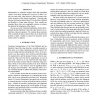Free Online Productivity Tools
i2Speak
i2Symbol
i2OCR
iTex2Img
iWeb2Print
iWeb2Shot
i2Type
iPdf2Split
iPdf2Merge
i2Bopomofo
i2Arabic
i2Style
i2Image
i2PDF
iLatex2Rtf
Sci2ools
ICIP
2003
IEEE
2003
IEEE
Geometric segmentation of 3D structures
Segmentation in volumetric images deals with separating `objects' from their `background' in a given 3D data. Usually, one starts with `edge detectors' that give binary clues on the locations of the objects boundaries. Classical edge detectors that can be adopted from 2D are the Marr?Hildreth, and Haralick or Canny edge detectors. Next, usually one integrates these clues into meaningful contours or surfaces that indicate the boundaries of the objects. We use our recent variational explanation for the Marr? Hildreth and the Haralick?Canny like edge detectors to extend these classical operators. We combine these operators with a minimal deviation measure that can be tuned to the problem at hand. Finally, an improved `geometric active surface model' is defined.
Canny Edge Detectors | Classical Edge Detectors | Edge Detectors | ICIP 2003 | Image Processing | Minimal Deviation Measure | Objects Boundaries |
| Added | 24 Oct 2009 |
| Updated | 24 Oct 2009 |
| Type | Conference |
| Year | 2003 |
| Where | ICIP |
| Authors | Ron Kimmel |
Comments (0)

